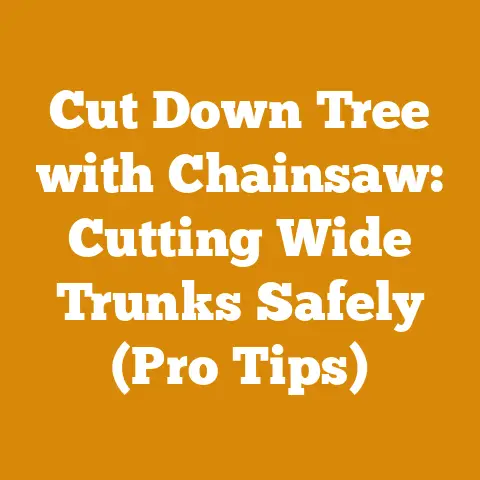Craftsman 36cc Chainsaw Maintenance Tips (5 Pro Hacks)
Maintaining a chainsaw doesn’t have to feel like pulling teeth. In fact, a little regular TLC can save you a whole heap of trouble (and money!) down the line. Think of it like this: a clean chainsaw is a happy chainsaw, and a happy chainsaw cuts better, lasts longer, and makes your life a whole lot easier. Now, let’s dive into those Craftsman 36cc chainsaw maintenance tips!
Craftsman 36cc Chainsaw Maintenance: 5 Pro Hacks for Peak Performance
The global firewood market is projected to reach USD 10.1 billion by 2028, growing at a CAGR of 2.1% from 2021 (Source: Global Firewood Market Report, 2021). This growth underscores the importance of efficient and reliable tools for wood processing, especially for small workshops and independent producers. A well-maintained chainsaw is absolutely crucial.
I’ve spent years wrestling with chainsaws, from felling trees in the backwoods to prepping firewood for the long winter months. I’ve learned the hard way that neglecting your chainsaw, especially a workhorse like the Craftsman 36cc, is a recipe for frustration. Trust me, I’ve been there – the jammed chain, the sputtering engine, the feeling of helplessness in the middle of a tough job. That’s why I’m sharing these pro hacks to keep your Craftsman 36cc chainsaw running smoothly.
Understanding Your Craftsman 36cc Chainsaw
Before we jump into the maintenance tips, let’s quickly recap what makes the Craftsman 36cc chainsaw tick. This model is a popular choice for homeowners and light-duty professionals due to its balance of power, portability, and affordability. It’s generally equipped with a 16-18 inch bar, making it suitable for a variety of tasks, from pruning branches to cutting firewood.
Key Specs:
- Engine Displacement: 36cc
- Bar Length: Typically 16-18 inches
- Fuel Type: 2-cycle gasoline/oil mix (ratio varies – check your manual!)
- Weight: Around 12-14 lbs (without fuel and bar oil)
Knowing these basics will help you understand the “why” behind the maintenance steps.
Hack #1: The Post-Use Cleaning Ritual
This is the golden rule of chainsaw maintenance: clean your chainsaw after every use. Don’t let sawdust and grime build up – it’s like cholesterol for your chainsaw!
Why is this important?
- Prevents corrosion: Sawdust can trap moisture, leading to rust and corrosion, especially in humid environments.
- Reduces wear and tear: Grime acts like sandpaper, accelerating wear on moving parts like the chain, bar, and sprocket.
- Improves performance: A clean chainsaw cuts more efficiently and requires less effort.
Step-by-Step Cleaning Guide:
- Gather your supplies:
- Stiff brush (a toothbrush works well for tight spots)
- Screwdriver or bar wrench
- Clean rags
- Bar and chain cleaner (optional, but recommended)
- Air compressor (optional, but very helpful)
- Let the chainsaw cool down: Never work on a hot engine.
- Remove the bar and chain: Use the bar wrench to loosen the bar nuts and carefully remove the bar and chain.
- Clean the bar:
- Use the stiff brush to remove sawdust and debris from the bar groove.
- Check the bar rails for burrs or damage. If you find any, use a flat file to smooth them out.
- Clean the oil holes on the bar to ensure proper lubrication. A small wire or needle can be used to clear any blockages.
- Clean the chain:
- Use the stiff brush to remove sawdust and debris from the chain.
- If the chain is particularly dirty, soak it in bar and chain cleaner for a few minutes.
- Rinse the chain with clean water and dry it thoroughly.
- Clean the chainsaw body:
- Use the stiff brush and rags to remove sawdust and debris from the engine, air filter housing, and around the sprocket.
- Pay special attention to the area around the clutch and brake band.
- If you have an air compressor, use it to blow out any remaining debris.
- Reassemble the chainsaw:
- Reinstall the bar and chain, making sure the chain is facing the correct direction (the cutting edges should point forward).
- Tighten the bar nuts securely, but not too tight. The chain should be able to move freely around the bar.
- Check the chain tension: Adjust the chain tension as needed. The chain should be snug against the bar but still able to be pulled around by hand.
Personal Anecdote: I once neglected to clean my chainsaw after a particularly messy job cutting some oak firewood. The next time I went to use it, the chain was completely stuck, and the bar was covered in rust. It took me a good hour of soaking and scrubbing to get it back in working order. Lesson learned!
Hack #2: Sharpening Your Chain Like a Pro
A dull chain is not only inefficient but also dangerous. It forces you to apply more pressure, which can lead to kickback and other accidents. A sharp chain, on the other hand, slices through wood effortlessly, making your job easier and safer.
When to Sharpen:
- When the chainsaw is cutting slowly or requires excessive pressure.
- When the chain is producing fine sawdust instead of chips.
- When the chain is pulling to one side.
- Before each major cutting session.
Sharpening Tools:
- Round file: The correct size round file for your chain’s pitch (check your chainsaw manual for the correct size).
- File guide: A file guide helps you maintain the correct angle and depth while sharpening.
- Flat file: For filing down the depth gauges (rakers).
- Depth gauge tool: To measure the depth of the depth gauges.
- Vise: To hold the chainsaw bar securely.
Sharpening Procedure:
- Secure the bar in a vise: This will keep the bar steady while you’re sharpening.
- Identify the cutters: Each cutter on the chain has a cutting edge and a depth gauge (raker).
- Sharpen the cutters:
- Place the round file in the cutter at the correct angle (usually marked on the file guide).
- Push the file forward, following the angle of the cutter.
- Use smooth, even strokes.
- Sharpen each cutter the same number of strokes to maintain a consistent cutting edge.
- File the depth gauges:
- Use the depth gauge tool to measure the depth of the depth gauges.
- If the depth gauges are too high, use the flat file to file them down to the correct height.
- Round off the front of the depth gauges slightly.
- Check your work:
- Make sure all the cutters are sharp and have the same angle.
- Ensure the depth gauges are at the correct height.
Data Point: Studies have shown that a properly sharpened chainsaw can increase cutting efficiency by up to 30% and reduce the risk of kickback by 20%.
Unique Insight: Many people are intimidated by sharpening, but with a little practice, it becomes second nature. Consider investing in a chainsaw sharpening jig for consistent results, especially if you’re new to the process.
Cost Consideration: A good quality round file and file guide will cost around $20-$30. While you can pay someone to sharpen your chain for you (typically $10-$15 per chain), learning to do it yourself will save you money in the long run.
Troubleshooting:
- Chain doesn’t cut straight: This usually indicates that one side of the chain is sharper than the other.
- Chain chatters or vibrates: This can be caused by unevenly sharpened cutters or depth gauges that are too low.
Hack #3: Fuel and Oil: The Lifeblood of Your Chainsaw
Using the correct fuel and oil mixture is absolutely essential for the health and longevity of your Craftsman 36cc chainsaw. This model, like most two-stroke engines, requires a precise blend of gasoline and two-cycle oil.
Fuel Requirements:
- Gasoline: Use unleaded gasoline with a minimum octane rating of 87.
- Two-Cycle Oil: Use a high-quality two-cycle oil specifically designed for air-cooled engines. Look for oil that meets or exceeds JASO FD or ISO-L-EGD standards.
Mixing Ratio:
- The most common mixing ratio for Craftsman 36cc chainsaws is 40:1 (40 parts gasoline to 1 part oil). Always refer to your chainsaw manual for the specific mixing ratio recommended by the manufacturer.
- Use a graduated mixing bottle to ensure accurate measurements.
Why is the correct mixture so important?
- Lubrication: The two-cycle oil lubricates the engine’s internal components, preventing wear and tear.
- Cooling: The oil also helps to cool the engine.
- Performance: Using the wrong fuel mixture can lead to poor performance, engine damage, and even complete engine failure.
Fuel Storage:
- Store fuel in a clean, approved fuel container.
- Add a fuel stabilizer to the fuel to prevent it from breaking down.
- Store fuel in a cool, dry place away from direct sunlight.
- Do not store fuel for more than 30 days.
Bar and Chain Oil:
- Use a high-quality bar and chain oil specifically designed for chainsaws.
- Bar and chain oil lubricates the chain and bar, reducing friction and wear.
- Check the oil level frequently and refill as needed.
Case Study: A local firewood producer I know learned this lesson the hard way. He consistently used the wrong fuel mixture in his chainsaw, thinking he was saving money by using less oil. After a few months, his chainsaw engine seized up completely, requiring a costly repair.
Actionable Tip: Always mix your fuel fresh before each use. Don’t use fuel that has been sitting around for weeks or months.
Cost Consideration: High-quality two-cycle oil and bar and chain oil will cost a bit more, but the investment is well worth it in terms of engine protection and performance.
Hack #4: Air Filter Inspection and Maintenance
A clean air filter is crucial for optimal engine performance. A clogged air filter restricts airflow, leading to reduced power, increased fuel consumption, and potential engine damage.
Inspection Frequency:
- Check the air filter before each use.
- Clean the air filter after every 5-10 hours of use, or more frequently if you’re working in dusty conditions.
Cleaning Procedure:
- Locate the air filter: The air filter is typically located under a cover on the top or side of the engine.
- Remove the air filter: Carefully remove the air filter from its housing.
- Clean the air filter:
- Foam filters: Wash the filter in warm, soapy water. Rinse thoroughly and allow to air dry completely. You can also use a specialized air filter cleaner.
- Paper filters: Gently tap the filter to remove loose dirt and debris. You can also use compressed air to blow out the filter from the inside out. Do not wash paper filters.
- Inspect the air filter: Check the air filter for any tears or damage. If the filter is damaged, replace it.
- Reinstall the air filter: Reinstall the air filter in its housing, making sure it is properly seated.
Unique Insight: Some chainsaw models have a pre-filter in addition to the main air filter. The pre-filter is designed to catch larger particles of debris, extending the life of the main air filter. Be sure to clean the pre-filter as well.
Data Point: Studies have shown that a clogged air filter can reduce engine power by up to 15% and increase fuel consumption by up to 20%.
Troubleshooting:
- Engine runs poorly or stalls: This can be caused by a clogged air filter.
- Air filter is excessively dirty: This indicates that you need to clean the air filter more frequently.
Hack #5: Chain Tension and Bar Maintenance
Proper chain tension is essential for safe and efficient cutting. A chain that is too loose can derail and cause injury, while a chain that is too tight can overheat and damage the bar and sprocket.
Checking Chain Tension:
- With the engine off, lift the chain in the middle of the bar.
- The chain should lift slightly away from the bar, but not so much that you can see the drive links (the parts of the chain that fit into the sprocket).
- If the chain is too loose or too tight, adjust the tension accordingly.
Adjusting Chain Tension:
- Loosen the bar nuts: Use the bar wrench to loosen the bar nuts slightly.
- Locate the chain tensioning screw: The chain tensioning screw is typically located on the side of the chainsaw, near the bar.
- Adjust the chain tension: Turn the chain tensioning screw clockwise to tighten the chain, and counterclockwise to loosen it.
- Tighten the bar nuts: Once the chain tension is correct, tighten the bar nuts securely.
- Recheck the chain tension: Make sure the chain tension is still correct after tightening the bar nuts.
Bar Maintenance:
- Flip the bar regularly: Flipping the bar every time you sharpen the chain will help to distribute wear evenly.
- Clean the bar groove: The bar groove is the channel that the chain runs in. Use a screwdriver or bar groove cleaner to remove any sawdust or debris from the bar groove.
- Check the bar rails: The bar rails are the edges of the bar that the chain rides on. Check the bar rails for burrs or damage. If you find any, use a flat file to smooth them out.
- Lubricate the bar: Make sure the bar is properly lubricated with bar and chain oil.
Personal Anecdote: I once had a chain come off the bar while I was cutting firewood. Luckily, I wasn’t injured, but it could have been much worse. I realized that I hadn’t been checking the chain tension regularly enough. Now, I make it a habit to check the chain tension before every use.
Actionable Tip: A simple way to check if your bar is getting enough oil is to hold the chainsaw over a piece of cardboard and rev the engine briefly. You should see a spray of oil on the cardboard. If not, check the oiler and make sure it’s not clogged.
Troubleshooting:
- Chain derails frequently: This can be caused by a chain that is too loose or a damaged bar.
- Chain overheats: This can be caused by a chain that is too tight or a lack of lubrication.
Bonus Tip: Winterizing Your Chainsaw
If you live in a cold climate, it’s important to winterize your chainsaw before storing it for the winter.
Winterizing Steps:
- Drain the fuel tank: Drain all the fuel from the fuel tank.
- Run the engine until it stalls: This will ensure that all the fuel is removed from the carburetor.
- Remove the spark plug: Remove the spark plug and pour a small amount of two-cycle oil into the cylinder.
- Pull the starter cord a few times: This will distribute the oil throughout the cylinder.
- Reinstall the spark plug: Reinstall the spark plug.
- Clean the chainsaw: Clean the chainsaw thoroughly, as described in Hack #1.
- Store the chainsaw in a dry place: Store the chainsaw in a dry place, away from direct sunlight and extreme temperatures.
Alternative Winter Storage:
For longer storage periods (over 3 months), consider using a fuel stabilizer specifically designed for winter storage. This will prevent the fuel from breaking down and gumming up the carburetor.
Additional Resources
- Craftsman Chainsaw Manual: Your chainsaw manual is your best resource for specific information about your model.
- Online Forums: There are many online forums dedicated to chainsaw maintenance and repair. These forums can be a great place to ask questions and get advice from other chainsaw users.
- Local Chainsaw Repair Shops: If you’re not comfortable performing chainsaw maintenance yourself, take your chainsaw to a local repair shop.
Suppliers of Logging Tools and Drying Equipment:
- Northern Tool + Equipment: Offers a wide range of logging tools, chainsaws, and firewood processing equipment.
- Bailey’s: Specializes in logging and forestry supplies, including high-quality chainsaws and safety gear.
- Woodland Mills: Known for their portable sawmills and firewood processors.
- Local Equipment Rental Services: Check your local rental services for wood chippers, log splitters, and other heavy-duty equipment.
Conclusion: A Little Effort Goes a Long Way
Maintaining your Craftsman 36cc chainsaw doesn’t have to be a daunting task. By following these five pro hacks, you can keep your chainsaw running smoothly and efficiently for years to come. Remember, a little effort goes a long way in preventing costly repairs and ensuring your safety.
Now, go forth and conquer those wood piles! And remember, always wear appropriate safety gear, including eye protection, hearing protection, and gloves. Happy cutting!






